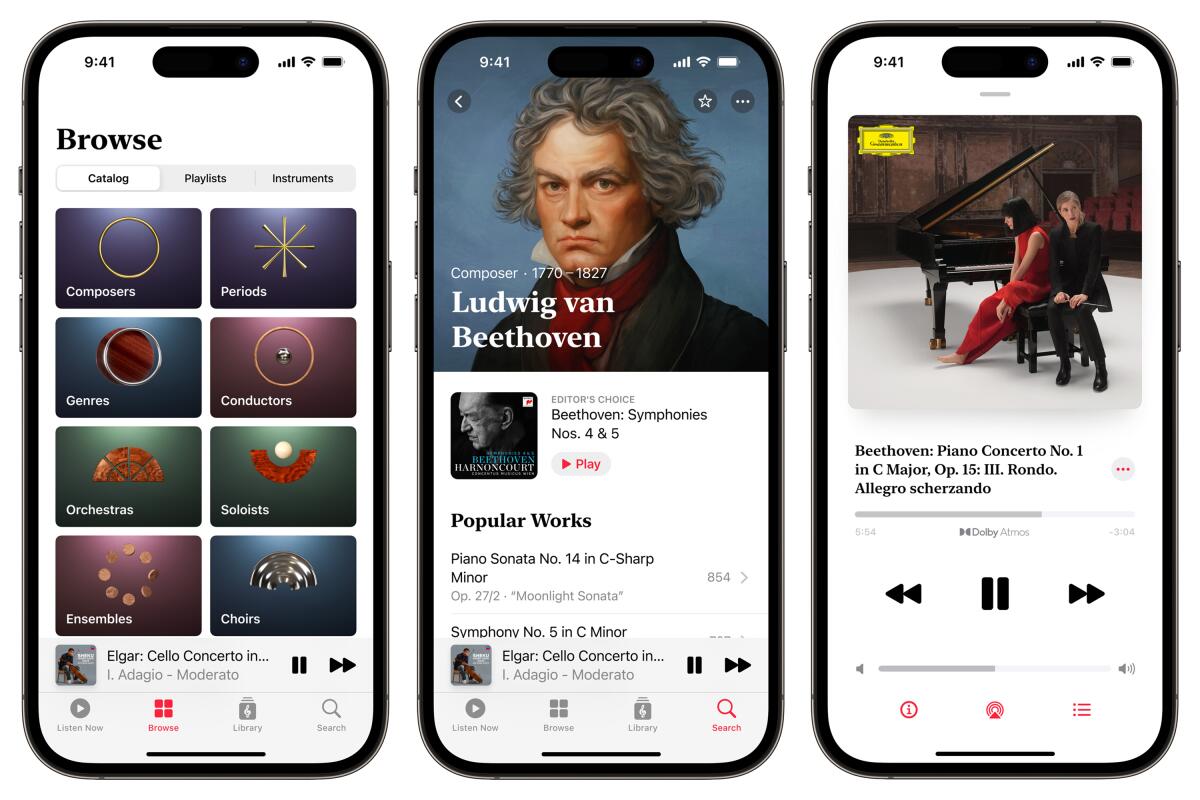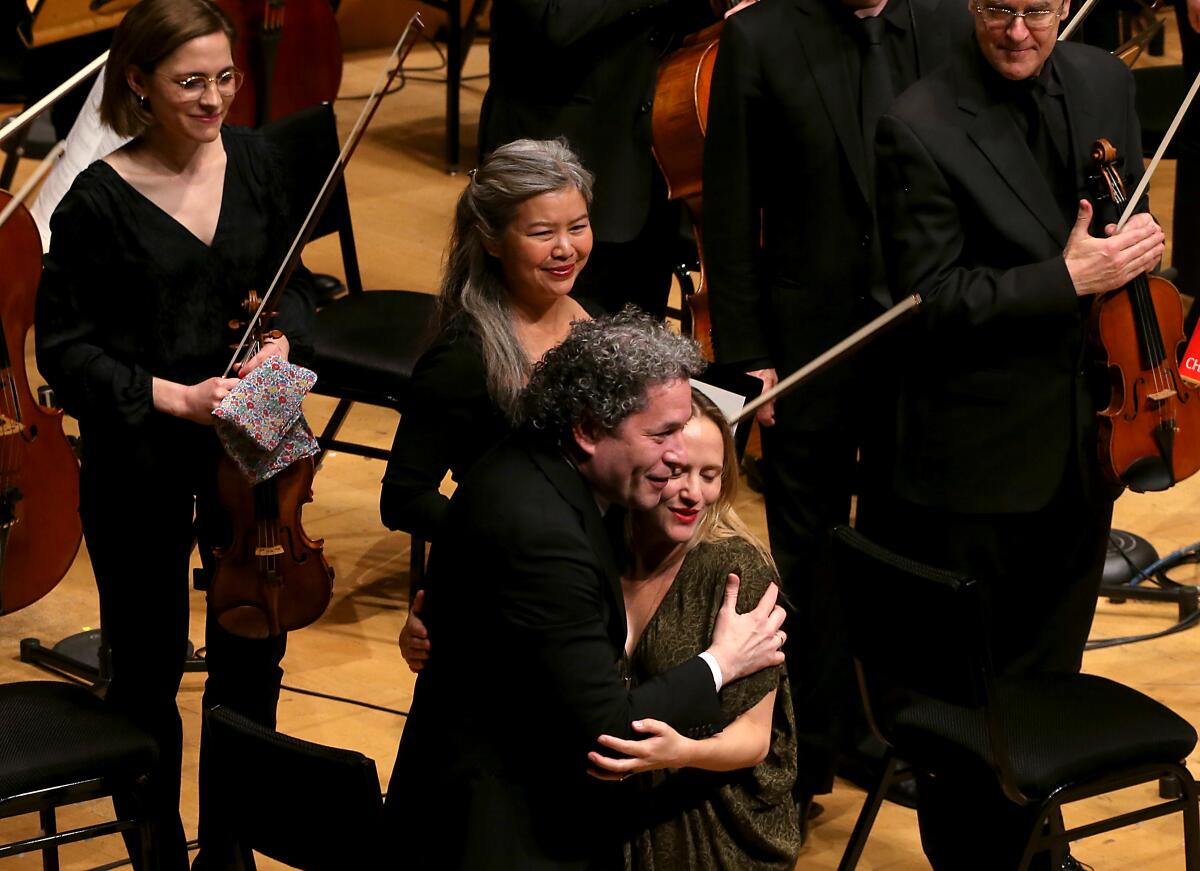Is Apple’s buzzy new classical music app worth the hype?

- Share via
Hello, this is Times music critic Mark Swed. After spending some quiet moments over the Memorial Day weekend perusing Apple Music Classical, I’m filling in for the Essential Arts’ essential Carolina A. Miranda.
The other day at a cellphone shop, I had toyed with a fulgent Samsung flip phone on display while waiting for a salesperson. What might the Apple Music Classical app look like on this temptingly super-sized screen rather than on the only-by-comparison puny iPhone I was after? There was no way to know. Although Apple had promised when it launched the app in March that it would provide an Android version at some point, it wasn’t yet available.
The drop came unexpectedly this week, now making Apple Music Classical more widely accessible. And the app looks great on my new iPhone, a plenty-big brick. Apple knows how to keep up appearances. If only looks were everything.
Thanks to iTunes, the iPod and its latest music apps and other devices, Apple has proved an irrepressible force over two decades in opening up and making accessible the widest possible world of music. But in the process Apple also has created problems.
That begins with the egregious cultural co-option of classifying every conceivable form of music a song. According to Apple, the movement of a symphony is a song; a fugue is a song; a raga is a song; thousands of dance forms from a vast array of cultures are, although they are decidedly not, supposed songs.
Given the complexity of providing metadata for classical music, names of composers, performers and even the pieces themselves often were left incomplete. If something didn’t fit the format of a commercial, conventional song, you were discouraged from checking it out. If you happened upon something you found intriguing, you wouldn’t know where to turn, although Apple would offer its suggestions that kept you in the same narrow silo. In too many ways, the world of music got smaller, not larger.
Then there was the digitally compressed MP3 format, which Apple helped popularize, because it used so little storage space that tiny iPods could hold whole music libraries. But it is the most compromised audio format I have ever encountered, from 78 rpm records to cassette tapes. Based on something called “psychoacoustic modeling,” it messed with your mind to make you think you are hearing what you are not.
Apple was hardly alone in this, especially once streaming got going. Spotify, take a bow. Step up, Amazon. Others have come and gone, or still linger. But it was these shiny Apples, hugely aided by the launch of the iPhone and all the other must-have Apple products, hardware and soft-, that played an indispensable role. Nor is Apple alone in fostering streaming’s most egregious sin, namely robbing musicians of a living wage through paltry royalties.
With Apple Music Classical the company has begun to atone. Two summers ago, Apple purchased Primephonic, the relatively classy classical music streaming site run out of the Netherlands and partly supported by composer Gordon Getty. Apple Music had been upgrading its sonics, first with what it called lossless (which is meant to be equivalent to the sampling rate of CD), then with the addition of higher resolution. Apple further added Dolby Atmos, the surround-sound feature found in cinemas and fancy home theater set-ups, to create a supposedly life-like you-are-thereness, too often with the artificial help of AI. While designed for several speakers and a sub-woofer, Dolby Atmos can work to some extent with a stereo system, with a single smart speaker (sort of) and fairly effectively with headphones or earbuds (which Apple also had begun marketing).
What Apple has added to Primephonic is its huge archive of millions of selections, the best search function found anywhere and lots of goodies. It has made deals for exclusive material with the Philharmonics of Vienna, Berlin and New York, Paris Opera and the Metropolitan Opera, and many others. It offers a basic multiple-hour “Story of Classical.” It’s got playlists programmed for moods and ones curated by star performers, Yo-Yo Ma and Lang Lang among them.
There is a feature called “Track by Track” that includes South African cellist Abel Selaocoe describing each track in his wonderful recent album, “Where Is Home,” Hilary Hahn offering her take on each movement of Bach’s solo violin partitas and sonatas, and Icelandic pianist Víkingur Ólafsson explaining why he chose what he did for his much-admired “Mozart & Contemporaries.”
Apple also is happy to guide users toward “Essential Albums,” “Composer Essentials,” “Albums of the Month,” “Albums We Love,” etc. Who is the “we” they speak of? We’re not told. Hidden away at the very bottom of the classical music section of Apple Music on the computer app, you will find a list of “curators,” mainly record companies and performance institutions. It is not clear, however, that this means an extra penny goes to the artists who make the music or if this is a sponsorship that puts even more money in the coffers of one of the most profitable companies in the world.
All this is intended to be audience-friendly, especially to anyone looking for a way into classical music. But devotees aren’t neglected. If you search for, say, Vivaldi’s “Four Seasons,” you will be presented with a varied, and well-selected, handful of suggested recordings. For the hardcore, there is a full list that required me to make 58 finger swipes on my phone to fully scroll down.
I particularly like the feature “Hidden Gems,” where you might come across the obscure Hungarian 20th-century composer László Lajtha, who I discovered is worth knowing. I also learned of the pianist Luisa Imorde from her disc of the late Russian jazz-influenced Nikolai Kapustin, who has become lately in vogue.
Yes, Apple keeps up appearances. But when it comes to the actual musical experience, as opposed to the app experience, you run into problems. The app is designed for the phone. You can get it on the iPad, but it’s the phone app blown up, inelegant and harder to use. There is no app for the computer, but you can find all the material in the classical music section of Apple Music. However, when I streamed it through my computer, the resolution was limited to lossless on the three different DACs (or digital to analog converters) I used.
Streaming, in general, can be a sonic nuisance. Connecting the iPhone properly to your hi-fi system with a cable is awkward unless you do it wirelessly. Someday Bluetooth may be capable of decent sound, just like someday we may have our phones be chips embedded in our brains. For now, the phone itself further adds unwanted noise, distortion and jitter.
Turn Dolby Atmos off. It’s phony. Listening to recordings made by the Los Angeles Philharmonic at Walt Disney Concert Hall concerts I’ve attended sounds far more realistic without Atmos’ attempt to bounce sounds off the walls. What I heard at a press demonstration of Atmos in the Apple offices in Culver City and particularly in a Mercedes SUV with a state-of-the-art Burmester sound system in the parking lot freaked me out with its massively impressive but outrageous sonic aggression.
As streaming becomes more sophisticated, more and more of us have turned to streamers, which aren’t connected to the computer but directly to your sound system from the internet. The difference in sound is significant. But Apple remains in its own closed universe and doesn’t have any provisions for using a streamer as does, say, Qobuz, the streaming site I’ve been using for several years.
Qobuz, which has a selection that competes in thoroughness with Apple and includes all genres, has been a pioneer in making high-resolution downloads and streaming. The site is available for a streamer, and when I compare the same recordings to Apple there is simply no competition.
Just as important, what Qobuz does, as do some other streaming sites, is PDF downloads of the liner notes to many albums (that’s still rare for older releases but more and more companies are now regularly making them available for their latest releases). Apple, however, chooses to provide its own brief synopsis.
This should be a dealbreaker. As welcome as it is, for instance, to have Selaocoe’s personal introductions to many of his native pieces, the liner notes for the album provide significantly more information and, most important of all, the texts of songs.
Indeed, for a company so invested in “song” — and that is still the term applied for everything when you use Apple Music on the computer — not to care about the words is troubling. My music education, like that of so many others, began as a kid by reading liner notes, many of which could be quite erudite.
I’ve hung onto records and CDs because the notes are worth saving. I’ve written my share of notes myself, and I can tell you, the money is very little (occasionally the compensation has been nothing more than a free copy of the recording, and once I even had to pay for that). Yet one tends to put a great deal of effort and care into the research and writing. Every time, I always thought about how much I learned from liner notes and how they helped create my passion for music.
There is easily enough value in Apple Music Classical that I will, gripe though I might, continue my subscription and find it well worth it. But only as a companion to Qobuz. The new phone, though, is quite nice in purple and works really well.

In the galleries
Times art critic Christopher Knight met David Hammons only once, when the elusive artist had a midcareer survey of his work in La Jolla. “We exchanged pleasantries, and he was gone,” Knight recalls in his review of a new documentary, “The Melt Goes on Forever: The Art & Times of David Hammons.” There are similarly only brief glimpses of the celebrity-averse Black artist, who is 79 and whom Knight describes as “among our greatest living artists”; he did not make himself available for the film.
But Hammons’ work speaks volumes. It is, Knight writes, “nothing less than a cultural touchstone for critical developments at the center of American art and life.” And at the heart of that is Hammons’ investigation of the act of looking, as when he considered one of the 20th century’s most influential artists, Marcel Duchamp. “Hammons looked at Duchamp,” Knight notes, “he looked at Black American life, he looked at how white art people looked at Duchamp and at Black Americans — and he looked askance.”
In yet another art documentary, although this one is a mockumentary, “White Balls on Walls” also deals with the issues of society, diversity and art. It follows the fraught attempts by Amsterdam’s Stedelijk Museum of Modern and Contemporary Art to diversify. “Amid the group’s proactive actions and sincere intentions,” Gary Goldstein writes in his review of the film, “irony and bemusement abound, at times worthy of a Christopher Guest outing.”

On and off the stage
“We all live by, act out and are trapped within versions of a standing order, whether it’s the roles we play in our family or the clothes we unconsciously wear to signal our identity,” Tina Landau tells The Times’ Ashley Lee about “A Transparent Musical,” which Landau is directing at the Mark Taper Forum. The show is a musical adaptation of Amazon’s award-winning TV series “Transparent,” about the impact on a Los Angeles Jewish family after their patriarch comes out, at age 75, as a transgender woman.
Times theater critic Charles McNulty was a fan of the “Transparent” TV series throughout its four seasons until it came to an untimely and unsatisfying end with an out-of-the-blue musical number. But he notes in his review that for all his sympathy for what “A Transparent Musical” attempts, the musical hardly has the Tolstoyan depth to deal with its important issues. “If someone had blindfolded me and brought me to this production,” McNulty writes in his review, “I would have assumed that I was watching a performance by a talented and extremely well-funded amateur troupe in residence at an LGBTQ+ community center that was inspired by the series.”

Classical notes
The week before Gustavo Dudamel returned to Walt Disney Concert Hall to lead the final two concerts of the Los Angeles Philharmonic season, he stopped off in New York for his first performance since being named the next music director of the New York Philharmonic, three years hence. The audience reportedly loved his performance of Mahler’s Ninth Symphony, and Dudamel was feted with a massive celebrity photo spread in the New York Times. But the paper’s critic Zachary Woolfe, like the New Yorker’s Alex Ross, worried about the performance’s lack of character. It might be noted, however, that Dudamel could hardly be in his element, feeling his way for the first time in the newly renovated David Geffen Hall but having to rehearse in the very different acoustic of Carnegie.
Back home in Disney, Dudamel was in his element, offering two exceptional world premieres — Ellen Reid’s “West Coast Sky Eternal” and Gabriella Smith’s “Lost Coast: Concerto for Cello and Orchestra” — along with a raptly considered reading of Beethoven’s Seventh Symphony.
Enjoying this newsletter? Consider subscribing to the Los Angeles Times
Your support helps us deliver the news that matters most. Become a subscriber.
In a star-studded charity gala in Salzburg, Austria, to celebrate his 80th birthday, Dudamel mentor Daniel Barenboim, who has been struggling with a neurological disorder, surprised the audience by coming up onstage to conduct the second half of the program.
Essential happenings
In his Times newsletter L.A. Goes Out, Steven Vargas highlights some of the LGBTQ+ events that begin Pride Month, be they dance, visual art or cinema.
Matt Cooper, The Times’ listings coordinator, has more Pride offerings for the weekend that range across town from Santa Monica Place and Third Street Promenade to Mariachi Arcoiris de Los Ángeles and a street fair in West Hollywood.
Moves
Oliver Hartmann has been named the new director of the Thomas Mann House in Pacific Palisades. Hartmann, who has training in classical and contemporary dance as well as a doctorate in Japanese studies, previously was head of the Goethe-Institut in Shanghai.
Irene Georgia Tsatsos is leaving her post as director of exhibition programs and chief curator at the Pasadena Armory.
Passages
Kaija Saariaho, the Finnish composer who has had a transformative effect on late 20th century and early 21st century music through her operas and many vocal, instrumental and electronic pieces, as well as having been a life-long friend of Esa-Pekka Salonen and informal member of the L.A. Phil family, died Friday morning of brain cancer at her home in Paris at 70.
Robin Wagner, who designed sets for “Hair,” “Jesus Christ Superstar,” “Angels in America” and some 50 more Broadway shows, has died at 89.
Ingrid Haebler, the Austrian pianist whose suavely winning Mozart recordings became bestsellers, has died at 96.
Ilya Kabakov, the Ukrainian-born conceptual artist who had a wry take on Soviet art, has died at 89.
In the news
— Pianist Mitsuko Uchida, who is performing with the Los Angeles Philharmonic this weekend, has been named music director of next summer’s Ojai Festival.
— When Fresno passed Measure P, it promised millions of dollars to be spent on the arts. The Fresno Bee reports that arts groups in the city are not so sure about that.
— Former Los Angeles Philharmonic Dudamel Conducting Fellow Jonathon Heyward, who becomes the first Black music director of the Baltimore Symphony this fall, has been reimagining the Mostly Mozart Orchestra, the long-time summer attraction at Lincoln Center in New York.
And last but not least ...
Guardian classical music critic Fiona Maddocks has written a moving account of working on a book about Rachmaninoff’s post-Russia later years (he died in Beverly Hills) while she was nursing her dying husband, British avant-garde painter and printmaker Tom Phillips, R.A., who preferred John Cage to Rachmaninoff.
The biggest entertainment stories
Get our big stories about Hollywood, film, television, music, arts, culture and more right in your inbox as soon as they publish.
You may occasionally receive promotional content from the Los Angeles Times.




